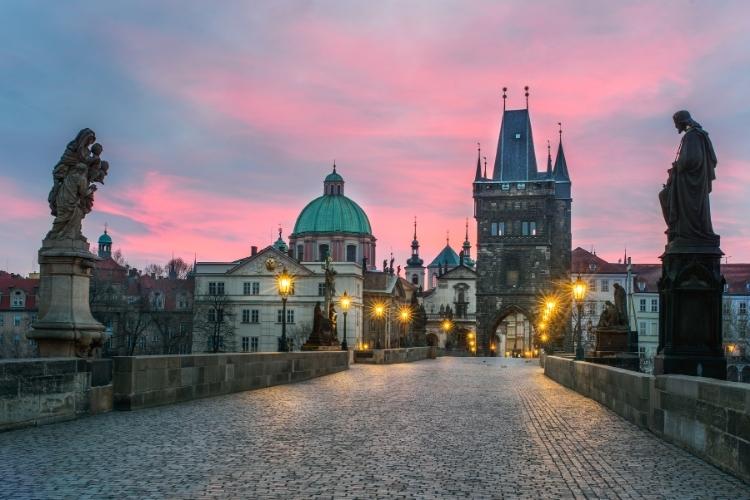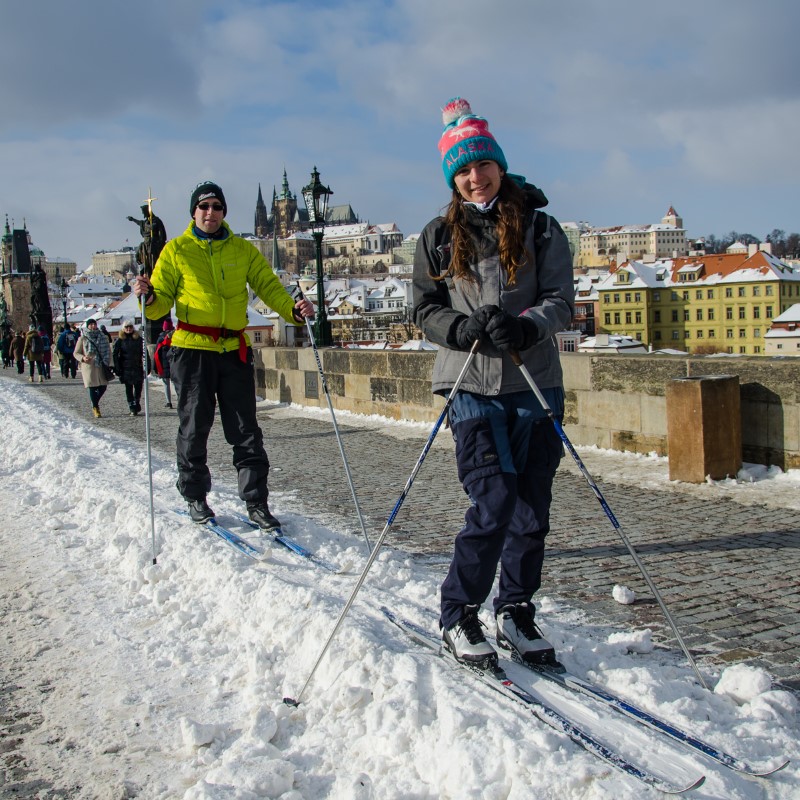
Written by local experts Adriana & Matěj
Adriana and Matěj Halouskovi are travel bloggers behind the successful blog Czech the World.
Matěj was born in Prague and has lived here his entire life and Adriana moved here 6 years ago.
We have traveled to more than 60 countries, but if we could tell you what place we know the most, it is our city.
Charles Bridge is the oldest stone bridge in Prague. Prague can be proud of this landmark since 1402. The Charles Bridge is decorated with 30 Baroque statues. It is one of the most important technical and historic monuments in Prague and the whole Central Europe. Charles is must-do even if you have just 2 days in Prague.
The Charles Bridge used to be called Prague Bridge or Stone Bridge until 1870. The bridge was built at the former place of Judith‘s Bridge, which was destroyed by floods. It is the second oldest bridge in the Czech Republic. Charles Bridge is one of the most visited tourist sites in Prague and many visitors have it really high on their Europe bucket list.
Charles Bridge – What shouldn’t be missed
The Charles Bridge has been part of the UNESCO World Cultural Heritage since 1992. It is no wonder that this massive construction is still an admirable piece of work even nowadays. The Royal Route have led through the Charles Bridge since the era of Charles IV. Czech kings had the honor to ride through the Royal Route prior the crown ceremony at the Prague Castle. Nowadays you can meet street artists and painters at the Charles Bridge.
Charles Bridge Towers at Malá Strana (Lesser Town)
The entrance to Charles Bridge from Malá Strana is guarded by 2 towers: the shorter one – Judith’s Tower is built in Romanesque style (it was a part of the previous Judith’s Bridge), and newer and higher Gothic tower.
If you are interested in going up to the tower, the entrance fee is 100 CZK.
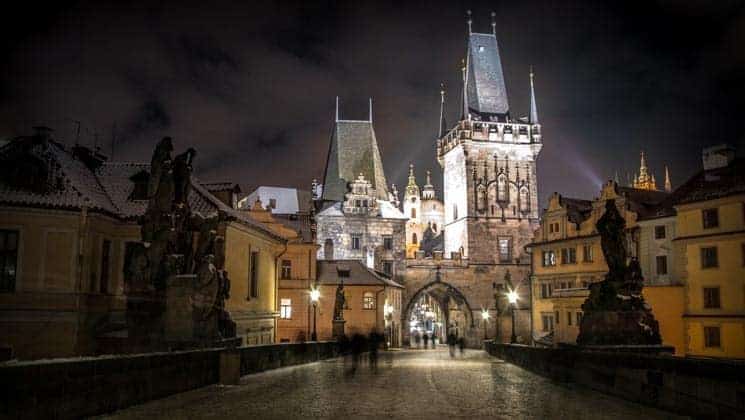
Old Town Bridge Tower
On the other side of the Charles Bridge, there is the Old Town Bridge Tower. This Bridge Tower is considered to be one of the most beautiful Gothic buildings in Europe. The Old Town Bridge Tower was built by Petr Parléř (who built also St. Vitus Cathedral). The gate also represents a type of triumphal arch for future Czech kings who were passing through the gate towards their coronation.
The tower can be visited every day from 10.00 AM, the entrance fee is 100 CZK. 138 steps are waiting for you on the way up.
Stairs to Kampa Island – the way to Lennon’s Wall
If you are walking through the Royal Route from Prague Castle, make a sidewalk to Kampa (a small island on the Vltava River). There is a Kanner’s Staircase, only 150 meters from Malá Strana Towers on your right-hand side, which will take you to Kampa. Walk to the Grand Priory’s Mill (Velkopřevorský mlýn) or Lennon’s Wall (famous Prague landmark, appreciated especially by street art fans).
A place where secret wishes are fulfilled
According to superstition, there is a place on the Charles Bridge, that fulfill the visitor’s secret wishes. Between the statue of St. John the Baptist (Jan Křtitel) and the sculpture of St. Norbert, Wenceslas, and Sigismund, is the old lattice as a reminder of the overthrow of John of Nepomuk’s (Jan Nepomucký‘s) body into the Vltava river. There is also a five-star archbishop’s cross on the bridge’s railing, which marks the place where the body was dropped.
If you follow these instructions, your wish should be fulfilled:
You should touch one of the bronze cross stars on the railing with each finger of your left hand, while the right hand should touch the image of lying John of Nepomuk on the lattice. The left foot should touch the small geodetic point that is placed on the pavement.
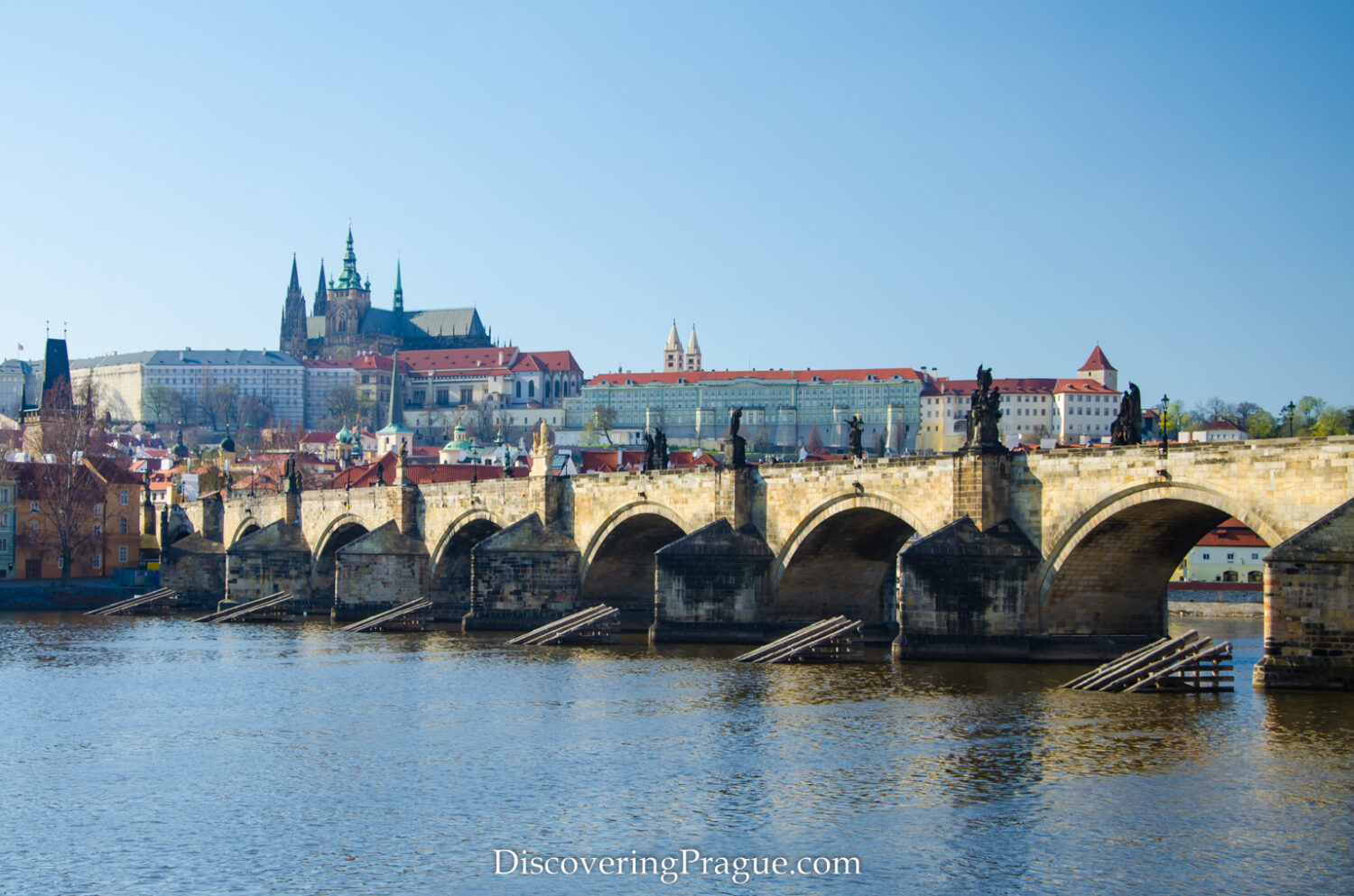
How to get to the Charles Bridge?
Charles Bridge connects Malá Strana (Lesser Town) and the Old Town. If you take a traditional tourist route through Prague, so-called Royal Route, which begins at Prague Castle, you will come to Charles Bridge from Malá Strana via Mostecká Street. From the opposite riverbank (at Old Town), Charles Bridge begins at Křižovnické Square. The bridge can be reached from the Old Town Square by Karlova Street. If you would like to avoid crowds, visit Prague in winter.
Nearest public transport to Charles Bridge from Malá Strana
The nearest stop to Charles Bridge is Malostranské náměstí. Mostecká Street will lead you directly to the Malá Strana Bridge Tower. If you go by Prague metro (subway), the nearest station is Malostranská (green line A), from where it is only one tram stop to Malostranské náměstí.
Nearest public transport to the bridge from the Old Town
The nearest metro station is Staroměstská (green line A). Trams also stop along the Vltava river – at the Staroměstská or Karlovy lázně tram stops.
You can find a suitable connection in Prague here (Prague Public Transport).

Interesting facts about Charles Bridge in Prague
- In 1621, baskets with heads of 12 lords executed on the Old Town Square were hanged on Charles Bridge as a warning.
- Between 1723 and 1866, the bridge was illuminated by oil lamps. Oil lamps were replaced in 1866 by gas lamps.
- After the bridge opening, the toll had to be paid for crossing. The toll was abolished in 1816.
- Until 1841, Charles Bridge was the only communication link across the Vltava River in Prague.
- In 1870, the bridge was officially named “Charles Bridge” (on the initiative of K. H. Borovský). Until then, the bridge was called Prague Bridge or Stone Bridge.
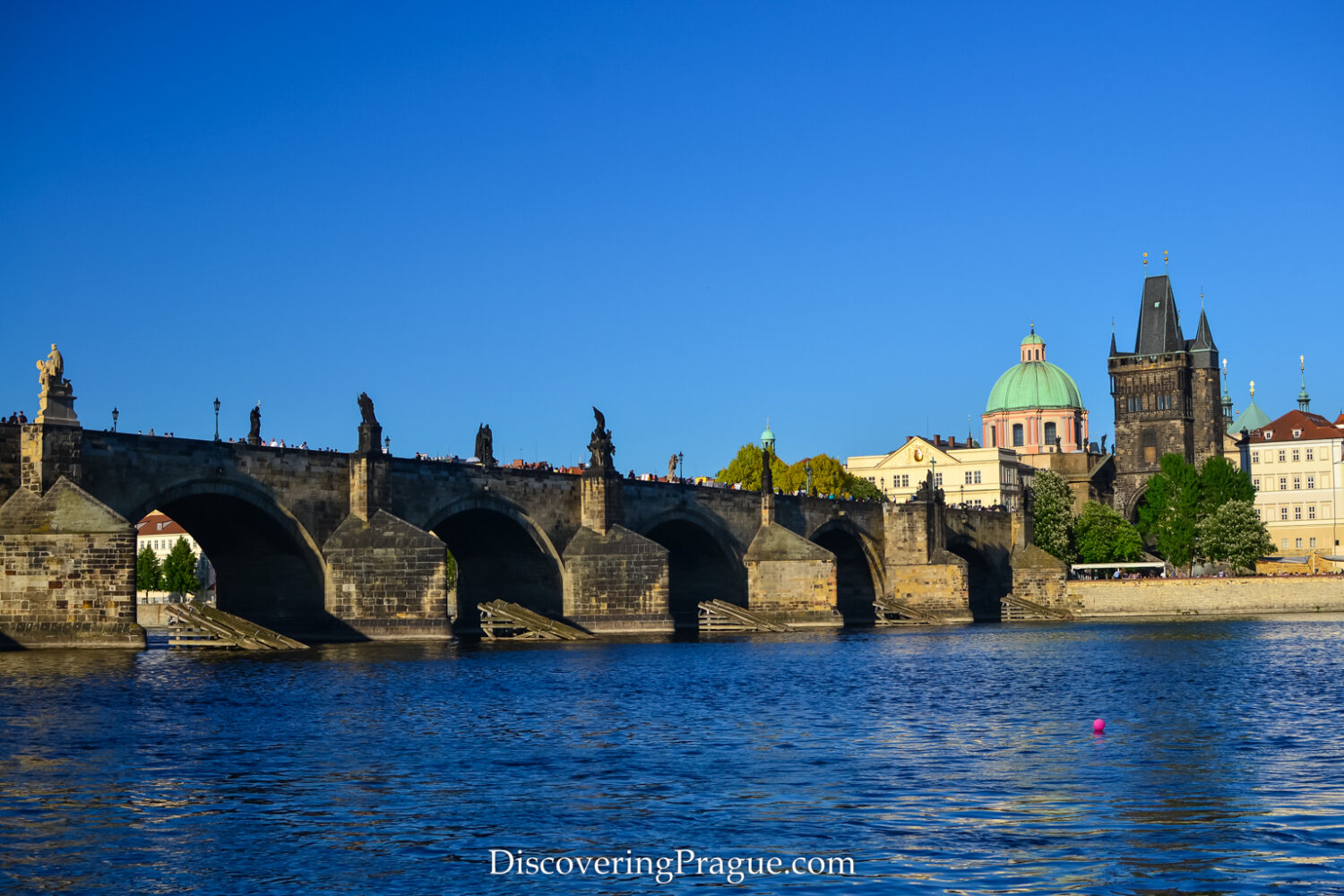
Construction and parameters of Charles Bridge
The construction of Prague Bridge started 15 years after the destruction of Judith’s Bridge by floods in 1357. Plans, finances, and materials needed to be collected first.
Charles Bridge facts
- Architects: Prague burgher Otto, later Petr Parléř – the builder of the St. Vitus Cathedral
- Length: 515.76 m
- Width: 9.5 m
- Height: 13 m
- Number of pillars: 15
Magic of numbers
Charles IV. himself laid the foundation stone of the new Stone Bridge. The date was set for July 9, 1357, at 5.31 AM. This date was chosen by royal astrologers. When numbers are written in the row like this: 1357 (year), 7 (month), 9 (day), 5.31 (time), they form the following magic line: 1 3 5 7 9 7 5 3 1, which is read from both sides identically.
Historians also take into consideration the date of 15th June because it is the day of St. Vitus.
Material
The bridge is built of solid sandstone blocks, which are connected by sandstone stucco mortar and hydraulic lime. The core of the bridge was built after the water was drained out, but still below the level of the Vltava river. Original gothic oak wood piles together with milestones were discovered during the repairs at the end of the 19th century.
Medieval builders of Charles Bridge also added various organic products to the mortar, such as milk; beer; wine; urine; blood; or even sugar. The total weight of the bridge material is estimated to be about one hundred thousand tons! Most of the stone came from quarries near Prague.
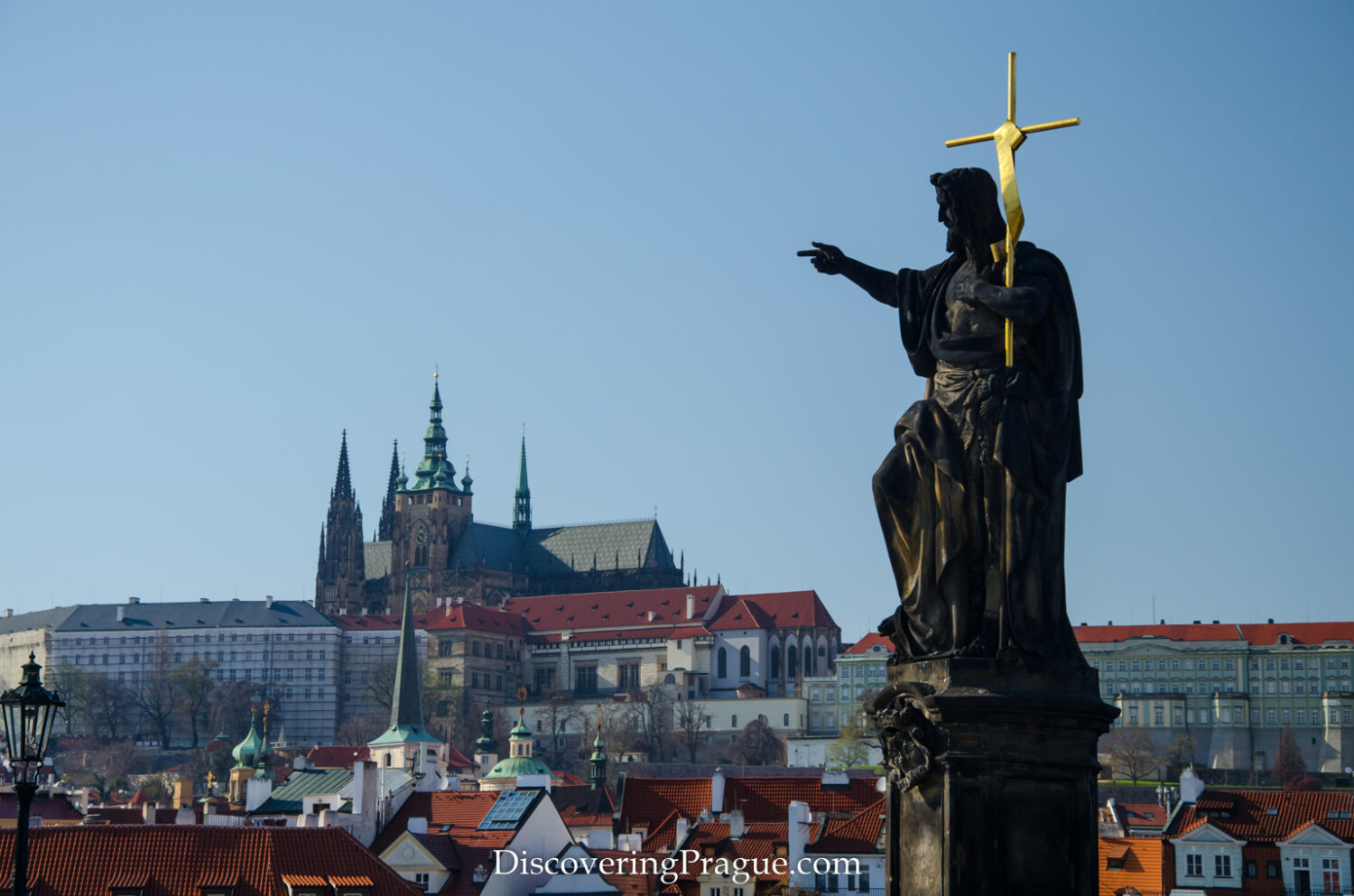
History of Charles Bridge
Previous Bridges
Originally there were only bound logs, the so-called thresholds, which formed a crossing over the Vltava river on the same place as present Charles Bridge.
- A wooden bridge is already mentioned in the written sources in the 10th century.
- Around 1170, King Vladislav II. build a stone bridge that was named after his wife Judita.
- Judith’s Bridge served Prague until 1342, when it was damaged during the spring floods and ice melt.
- The Charles Bridge was completed in 1402 (it was called Stone or Prague Bridge at that time).
- In 1870, it acquired its present name – Charles Bridge.
- Since 1965, only pedestrians are allowed on the bridge.
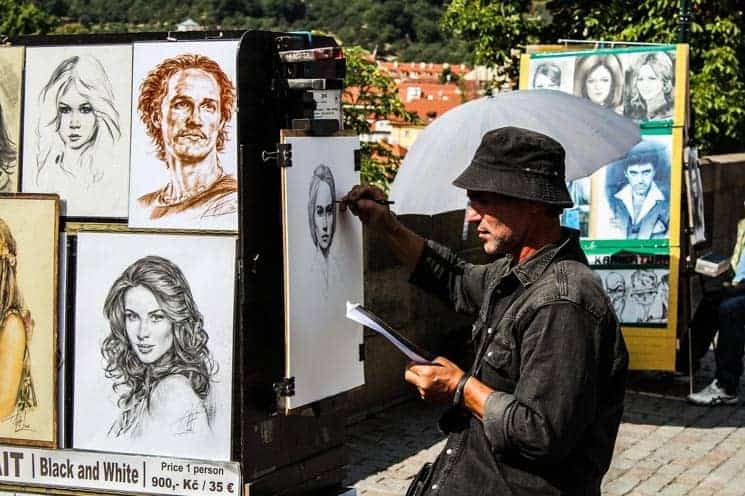
Transport on Charles Bridge
Complex transport regulations were created in 1759. Walk and ride was set on the right bridge side only. The so-called “koňka” (horse tram) started to run along the bridge in 1883. An electric tram came in 1905. 3 years later, it was discovered that the trams were damaging the bridge, so buses replaced them. Neither they were good for the bridge, so the public transport was suspended until 1932 when the buses with tires were introduced. Public transport existed on the bridge until World War II. Since 1965, Charles Bridge is for pedestrians only.
Rumors and legends of Charles Bridge
There are several legends about the construction of Charles Bridge in Prague. The most famous one is about eggs. It is said that the builders decided to add raw eggs to make the bridge strong and sturdy. Unfortunately, there were not enough eggs in the whole of Prague, so the king ordered to bring eggs from all over the kingdom. The wooden wagons drove to all corners of the Czech kingdom to bring the fragile cargo.
People from one small village – Velvary misunderstood the purpose. They were afraid that the eggs would break on the way, so they sent them boiled. The whole Prague laughed at people from Velvary, because of that, and that act was commemorated to them for centuries.
So, how was it with eggs in reality?
The scientific analysis from 2008 showed the presence of egg protein in the mortar taken from the bridge during its reparations. Two years later, another analysis contradicted this theory. According to the second analysis from 2010, eggs were not added to the mortar, but they found traces of wine and milk there.
Whatever material it is, Charles Bridge in Prague was built from quality “ingredients” that have helped it survive for centuries.
Statues and sculptures of Charles Bridge in Prague
The Charles Bridge is decorated with 30 Baroque statues and sculptures. The first statue on the bridge was a bronze statue of Jan Nepomucký (John of Nepomuk), as a reminder of his overthrow from the bridge in 1683. Other baroque sculptures were added to the bridge mainly between the years 1707 and 1714. The last sculpture – St. Cyril and Methodius, was added in 1928.
Most of the sculptures are made of sandstone. Sculptures are being replaced by copies of contemporary artists. The originals can be found in Lapidary of the National Museum in Prague or in Gorlice (the underground hall in casemates) at Vyšehrad.

Statues on the right side from Old Town towards Malá Strana
- The sculpture of the Virgin Mary and St. Bernard – by Matěj Václav Jäckel in 1709. The original is stored in Gorlice at Vyšehrad, Prague.
- The sculpture of the Madonna, St. Dominik and Thomas Aquinas – the author is Matěj Václav Jäckel (1708). The original is stored in the Lapidarium of the National Museum in Prague.
- Sculpture of St. Cross with Calvary – the cross was one of the first bridge decorations, already in time of Charles IV. The sandstone sculpture was created by Emanuel Max in 1861; the old bronze cross was made in 1629.
- Statue of St. Anna – the author is Matěj Václav Jäckel (1707); The original sculpture can be found in the Gorlice Hall at Vyšehrad.
- Sculpture of St. Cyril and Methodius – author prof. Karel Dvořák (1928-38); It was last sculpture added to the Charles bridge. It was installed at the anniversary of Charles University.
- Statue of St. John the Baptist – author Josef Max (1855); The original can be found in the Lapidarium of National Museum.
- Statue of St. Norbert, Wenceslas and Sigismund – by Josef Max (1853).
- Statue of St. John of Nepomuk – the most important statue of Charles Bridge. The only sculpture made of bronze was installed at the occasion of the 300th anniversary of overthrow John’s body off the bridge to the Vltava River. Staute was made by Jan Brokof (1683).
- Statue of St. Antonín Paduánský – the author is Jan Oldřich Mayer (1707).
- Statue of St. Jude Thaddeus – the author is Jan Oldřich Mayer (1708).
- Statue of St. Augustine – by Jeroným Kohl or his son Jan Bedřich Kohl (1708). The original is located in the Gorlice Hall at Vyšehrad.
- Statue of St. Kajetán – by Ferdinand Maximilian Brokof (1709).
- Statue of St. Filip Benicius – by Michal Bernard Mandel (1714).
- Statue of St. Vitus – the author is Ferdinand Maximilian Brokof (1714).
- Sculpture of St. Cosmas and Damian with Salvatore – by Jan Oldřich Mayer (1709).
Statues on the left side from Old Town towards Malá Strana
- Sculpture of St. Ivo – the original statue was created by Matthias Bernard Braun in 1711. It was the second statue created for Charles Bridge. The original is stored in the Lapidarium of the National Museum.
- Sculpture of St. Barbara, Margaret, and Elizabeth – authors are Jan and Ferdinand Maximilian Brokoff (1707).
- Pieta Sculpture – by Jan Brokoff (1695-96). The original sculpture was placed in the courtyard of the hospital below Petřín Hill.
- Statue of St. Joseph and Jesus – the original statue by Jan Brokoff (1706) was damaged during the fighting in 1848, now replaced by the work of Josef Max.
- Sculpture of St. Francis Xavier – by Ferdinand Maximilian Brokoff (1711). The original is stored in the Lapidarium of the National Museum.
- Statue of St. Christopher – the author is Emanuel Max (1857).
- Sculpture St. Francis Borgia – by Ferdinand Maximilian Brokoff (1710).
- Statue of St. Ludmila – the original sculpture by Matthias Bernard Braun from 1720 can be found in Gorlice at Vyšehrad.
- Sculpture of St. Francis of Assisi – the author is sculptor Emanuel Max (1855).
- Sculpture of St. Vincent Ferrer and Procopius – by Ferdinand Maximilian Brokoff (1712).
- Statue of St. Nicholas of Tolentino – by Jeroným Kohl (1708). The original is stored in Gorlice in Prague’s Vyšehrad.
- Sculpture of St. Luitgardis – is considered as the highest quality artwork of Charles Bridge. The author is Matthias Bernard Braun (1710). The original is stored in the Lapidarium of the National Museum.
- Statue of St. Vojtěch (Adalbert of Prague) – by Ferdinand Maximilian Brokoff (1709), the original is deposited at Vyšehrad.
- Sculpture of St. John of Matha, Felix of Valois and Ivan – One of the most famous sculptures. The author is F. M. Brokoff (1714).
- Statue of St. Wenceslas, patron of the Czech land – by Josef Kamil Böhm (1858).
If you want to know exactly what statue is who’s, have a look at Mapy.cz. Every single sculpture of the Charles Bridge is named there.
Charles Bridge Museum
If you want to explore the history of the Charles Bridge even more, visit the Charles Bridge Museum, located in Old Town, right on the Križovnické náměstí (Křižovnické Square). The museum is open daily from 10:00 to 19:00. The entrance fee is 170 CZK.
The tour can be combined with a narrated cruise on the Vltava River. In this case you will pay 340 CZK as an entrance fee.

Webcam
Watch the current situation on Charles Bridge thanks to this webcam.
More tips for travelers in Prague
We have prepared a practical guide for you about Czech money. Where to get them and what to avoid? Check also this guide to Prague airport.
Day trips from Prague
- Karlštejn Castle: Insider Guide – Day trip from Prague
- Vyhlídka Máj – Viewpoint – Day trip from Prague
- 39 Best Places to Visit in the Czech Republic: Insider’s Guide
Check this great video about Charles Bridge:
Share this blog post for your friends.

